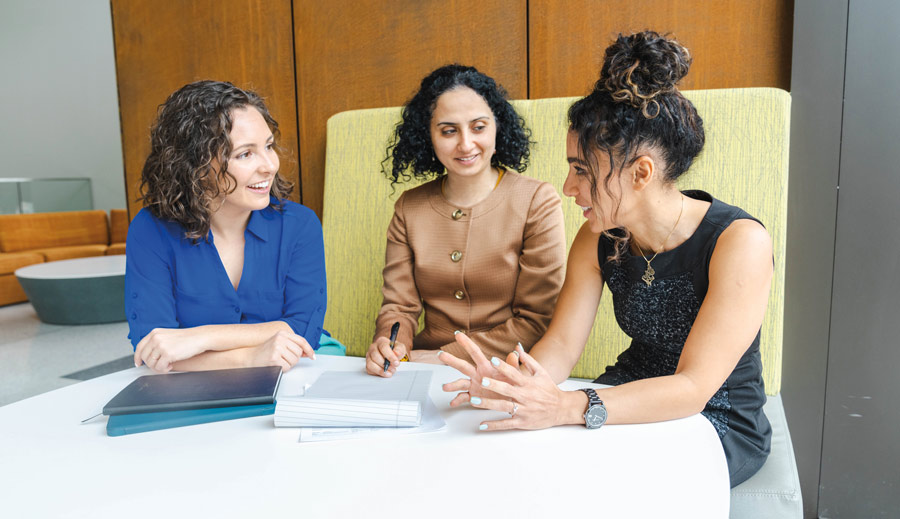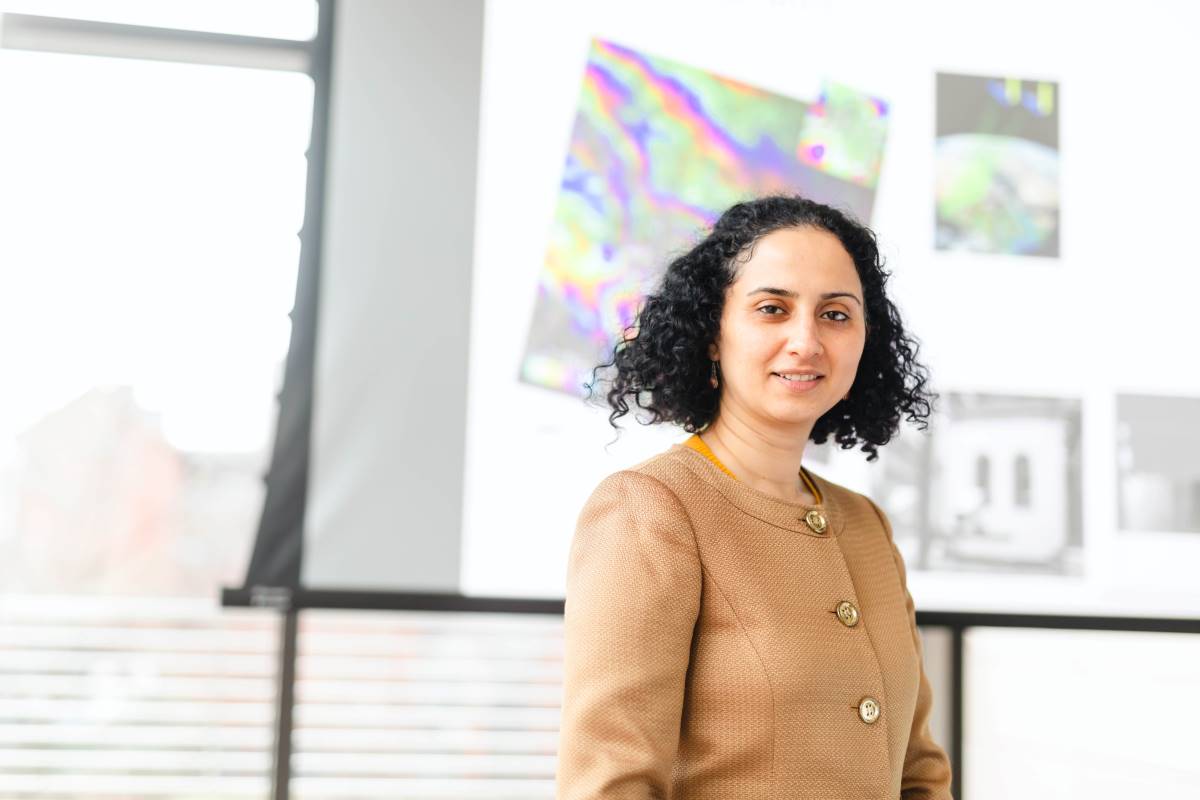
Civil and environmental engineers are on the front lines of efforts to adapt to a changing climate, where natural disasters are more frequent and natural resources increasingly scarce. Meet three new Rossin College faculty members who are taking innovative, data-driven approaches to sustainability challenges involving water, energy, and infrastructure—and their impact on people and communities.
Farrah Moazeni:
Securing modern water systems against cyberattacks

“Everyone should have equal access to water and to energy,” says Farrah Moazeni, an assistant professor of civil and environmental engineering. “Equity is the ideal, and so that’s our goal.”
Moazeni researches modern water infrastructure systems and how to make them more efficient and resilient. Water distribution systems comprise a vast, dispersed network that includes a water source like a reservoir or well, pumping stations that pressurize the water and allow it to travel long distances, and miles and miles of piping with countless valves that direct the flow to your faucet. In contrast to older systems that relied on telemetry, smart infrastructure is equipped with Internet-of-Things devices that gather data at various points throughout the system.
“And we can use the data to make sure the assets in the infrastructure are optimized and working at their best,” says Moazeni.
She and her lab also use the data to help secure the system against cyber attacks. Specifically, her team is focused on stealthy false-data injection strikes, where attackers are able to bypass detection algorithms and cause cascading failures across the water system. Moazeni says the goal is to identify vulnerable areas and, using artificial intelligence and machine learning, develop models that will thwart such interference.
“We’re also working to make sure that even if an attack happens, it’s mitigated in the shortest amount of time possible so that people don’t go without water for too long,” she says.
Data generated by these modern water systems can also be used to communicate with other systems. What people don’t often realize, says Moazeni, is that using water requires energy. It takes a lot of power to run treatment facilities and transport water—so the more water you use, the more energy you consume. Communication potentially can be leveraged to make both systems more efficient.
“So another part of my work is the controlling of interconnected water and energy systems,” she says. “There are a lot of us involved in this research project because each of these systems on its own is so complex—highly nonlinear and highly uncertain. Now imagine trying to control and optimize them simultaneously while meeting both water and energy demand. It’s very challenging.”
To meet that challenge, Moazeni is working with colleagues across civil and environmental engineering and electrical engineering to develop a framework called model predictive control that will help them coordinate the two systems.
The ultimate goal, she says, is to establish an urban system where water, energy, transportation, and building systems are all connected and optimized so that consumption, emissions, and costs all go down while access for all goes up.
“Imagine if you could do that for the entire United States,” she says. “You would have all these interconnected systems lending and borrowing from each other, depending on the need at any given moment, so that no matter where you live, you have uninterrupted, reliable, and resilient access to these resources.”
Maryam Rahnemoonfar:
A clearer vision for resilient communities

It can be difficult—and dangerous—for response teams to assess the aftermath of a major disaster with conventional techniques.
Ground-based robots are one alternative to collecting information on the damage, but they, too, can be hindered in speed and scope by a storm’s detritus. So first responders are increasingly relying on aerial and satellite imagery to reveal the situation on the ground.
“But this kind of imagery comes with its own challenges,” says Maryam Rahnemoonfar, an associate professor with a dual appointment in computer science and engineering and civil and environmental engineering. “When you take an image with a handheld camera from the ground, you can see all the objects and their features, like the doors and windows of a house. But with overhead imagery, one can only see the roof of the house, features are tiny, and there’s no balance between foreground and background. So it’s very difficult to decide if the house is totally destroyed, or if what you’re seeing is actually part of the road next to the house.”
Rahnemoonfar uses a combination of computer vision (i.e., simulating with computers how the human eye and brain interpret the visual world), machine learning, and remote sensing to develop better tools to analyze aerial imagery. Her cross-departmental appointment will allow her computer science students to work on a real-world problem, using advanced techniques not traditionally applied in civil engineering.
“The idea is to train the next generation of students in a domain that bridges these two disciplines,” she says.
Rahnemoonfar has long worked at the intersection of the two fields. For the past decade, she was leading a project using radar imaging to monitor changes in Arctic and Antarctic sea ice. The technique uses radio wavelengths to send out pulses of light and measures the strength and time with which those signals are reflected off an object to create three-dimensional images.
“Radar is the only sensor that can penetrate the ice and the soil to give us information below the surface,” she says. “The problem was that there were no advanced data analytics techniques to process all of that data. Our group was the first of its kind to develop the models to make sense of all of this data collected over the years. Ultimately, it will lead to a better understanding of the factors that affect sea-level rise.”
She previously led a multi-institution, multidisciplinary team that established an inaugural National Science Foundation HDR (Harnessing the Data Revolution) Institute for Data-Intensive Research in Science and Engineering. The institute studies polar regions and their contribution to sea-level rise using a combination of machine learning and physical models.
At Lehigh, Rahnemoonfar is leading a project to develop physics-informed machine learning algorithms for polar ice dynamics for the NSF-funded Leadership-Class Computing Facility in collaboration with the Texas Advanced Computing Center at the University of Texas at Austin. She’ll be employing similar techniques alongside colleagues who are developing models to better predict situations like flooding after a hurricane. If experts can better predict such events, she says, they can better prepare communities or help them evacuate.
Her cross-disciplinary appointment is a natural fit for her strengths as a researcher, and her skills as an educator. It’s also directly in line with her passion.
“I have always been interested in developing computer science and data-science techniques capable of solving real-world problems, particularly environmental issues,” she says. “These are problems that affect all of humanity, and that’s what makes my work so compelling and so satisfying.”
Gabrielle String:
Environmental health engineering for effective crisis response

Once people get involved, even the best engineering solutions can come undone.
“You could have the most technologically advanced filter system for treating drinking water sitting in someone’s kitchen, and they might never use it,” says assistant professor Gabrielle String. “Maybe it’s too expensive or complex to operate, or replacement parts are too difficult to find. Or maybe someone doesn’t trust the unit or the people implementing it, or like the taste of the treated water. Just because something works technically doesn’t mean it’s appropriate for—or will translate to—effective implementation in other contexts.”
String, who has a dual appointment in civil and environmental engineering and Lehigh’s College of Health, will help students learn to navigate scenarios where success of an implementation is often driven by external context and people, and not the limits of technology. In other words, she says, getting them comfortable with the gray areas.
“My work is not black or white, and the answers can often be very frustrating. But when someone says, ‘I’m not going to put chlorine in my water because I believe it’s a form of birth control,’ that information is critical to gauging the effectiveness of a water treatment program and to understanding the perceptions and beliefs of a community.”
As an environmental health engineer specializing in water sanitation and hygiene, String has worked in humanitarian response and development in countries like Haiti, Democratic Republic of the Congo, Nigeria, Bangladesh, and Mozambique. In the lab, she tests the efficacy of related protocols and technologies, and in the field, she evaluates their real-world implementation.
“What happens when you take these things out of the perfectly controlled lab environment? Some of these sanitation and hygiene programs—like treating cholera bacteria in water with chlorine—have been implemented for decades, but there’s actually a lack of evidence around many of the program guidelines,” she says. “So we investigate them, and help organizations draft recommendations to improve the response they’re getting to their interventions.”
Such investigation requires mixed methods research. The approach involves data collection (including interviews, surveys, observation, and lab analysis) that’s both quantitative and qualitative. Data points can show that water quality is improving, she says, but interviews with people can reveal whether results will continue. Mixed methods give a more holistic picture of a program and its effectiveness. By training her students in the approach, she’ll equip them with the skills necessary to navigate the ambiguities inherent when working with technology and people.
At Lehigh, String will continue her work supporting rural community-managed water-safety plans in the South Pacific, and looking at gloving protocols for healthcare workers in Ebola treatment units. She also hopes to restart a project evaluating safe water storage in jerricans (sturdy, narrow, flat-sided fluid containers) that was derailed by the pandemic. She is certain, however, that her position at the intersection of the university’s engineering and health colleges best speaks to her research—and the potential she has to impact students and expand their career aspirations.
“This is important research,” she says. “People deserve to receive programs that are evidence based and that are going to work. And if the work we do can provide that evidence, we can take one burden off the plate of responders during a humanitarian crisis. Because their mandate is saving lives.”
Story by Christine Fennessy
Photography by Christa Neu

